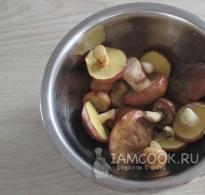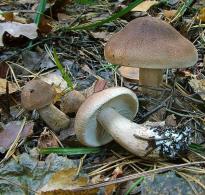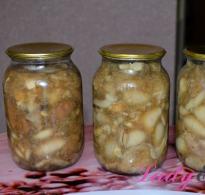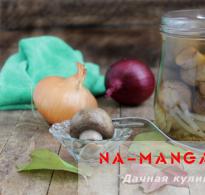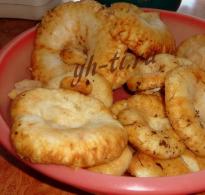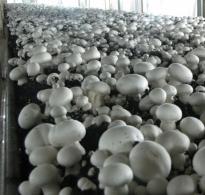How to salt butter at home: recipes, preparation of mushrooms
Butterlets are a welcome find for any mushroom picker. They are among the top ten edible mushrooms and are rightfully considered one of the most delicious, delicate, aromatic and healthy mushrooms, suitable for all types of processing: drying, pickling, pickling, pickling, freezing. We will tell you in detail in this article about the ways in which you can salt butter.
Read about pickling butter in this article.
The list of edible mushrooms allowed for industrial harvesting in Russia according to the current sanitary rules of SP 2.3.4.009-93 of 1993 includes two varieties of boletus: granular (Sullius granulatus) and late (Sullius luteus). Both those and others belong to the 2nd category (out of 4) nutritional value.
Butter mushrooms are undersized mushrooms with short, even, dense legs and flat-convex caps with a spongy (tubular) spore-bearing layer. Outside, the caps are covered with a thin yellowish or reddish-brown film, on the surface of which oily mucus- the main distinguishing feature of butter, in addition, they have a sponge pale or bright yellow color, and the light flesh does not change color at the cut or break. The caps of young mushrooms are bent with their edges inward, in late butter mushrooms, the bottom of the cap is covered with a white film, which, breaking during the growth process, remains in the form of a ring around the stem.
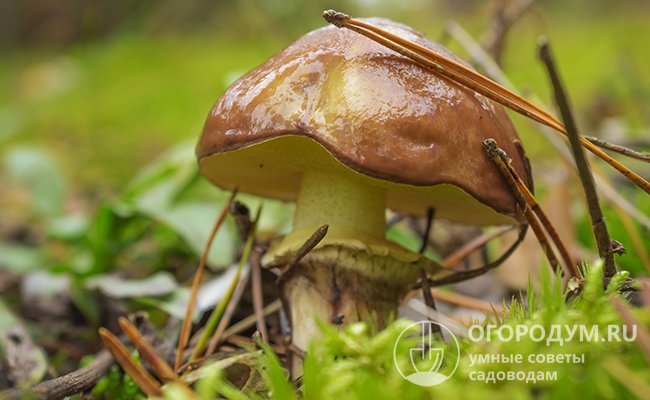
Boletus grows in numerous friendly families mainly in coniferous forests (especially young ones) in glades, burnt places, clearings, along the sides of paths. If one mushroom has caught your eye, then you need to carefully look around - others will most likely be found nearby. In a fruitful year, boletus is brought from the forest in buckets and baskets. The primary sorting is carried out during the collection process, rejecting all overripe, wormy, spoiled, flabby specimens. Only young, strong small-sized mushrooms are taken for preparation.
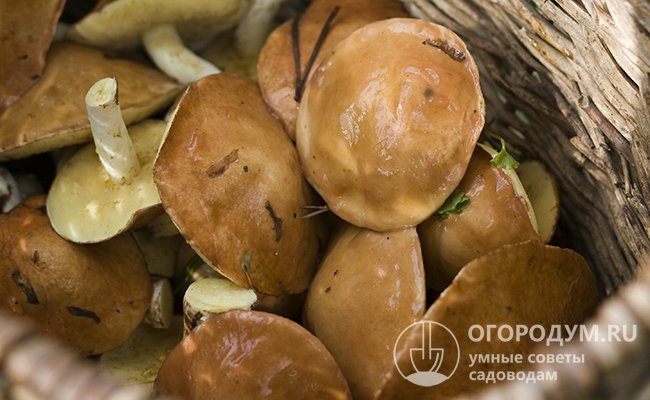
Preparation of oil for processing
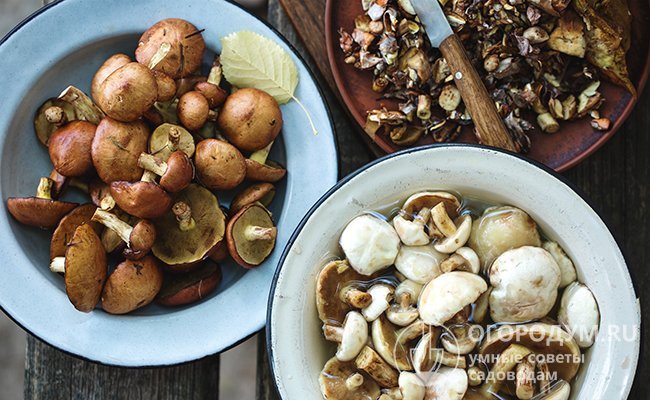
Long-term soaking of oil is not required. After cleaning, it is enough to rinse them several times under running water and then boil them. For boiling 1 kg of mushrooms prepare brine at the rate of 1 tbsp. l. salt and 3 g of citric acid per 1 liter of water. The oil is dipped in a saucepan with boiling brine, brought to a boil and cooked for 15-20 minutes over low heat, slightly melting and constantly skimming off the foam with a slotted spoon. Readiness is determined by the settling of the mushrooms to the bottom. After boiling, the butter is carefully transferred to a colander or sieve, washed thoroughly and allowed to drain. When boiled, mushrooms actively release their juice and lose more than half in volume. In this form, it is very convenient to freeze or preserve them.
The main ways of home salting butter
Salt boletus mushrooms can be done using traditional hot and cold methods, combining them with pickling or pickling. In order not to interrupt the natural mushroom taste and aroma, it is better to use spices in minimal quantities or refuse them altogether. Salt you need to take a stone cookery coarsely ground, not iodized. We offer you some simple recipes, according to which our mothers and grandmothers made the blanks.
Fermentation, which occurs during lactic acid fermentation, makes it possible to do without additional preservatives, gives mushrooms (vegetables and fruits) a special nutritional value and a pleasant sour taste.
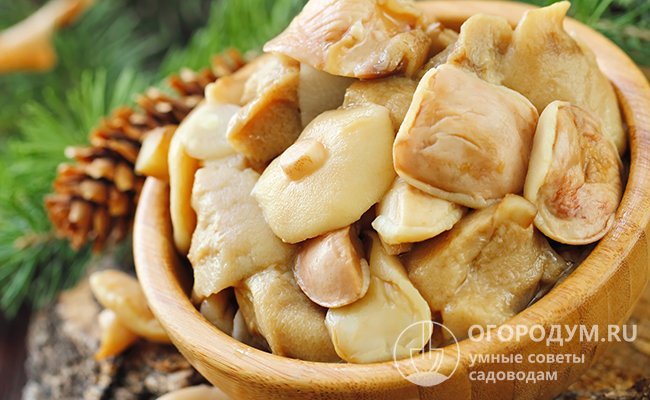
Servings / Volume: 4 l
Ingredients:
- boiled butter (boiled) - 5 kg;
- rock salt - 250 g;
- sugar - 80 g;
- milk whey - 2-3 tbsp. l.
Optionally, you can add:
- allspice and black pepper (peas) - 15-20 pcs.;
- laurel / oak leaf - 5-10 pcs.
Cooking technology:
- In a clean, dry (enameled, glass, ceramic or wooden) container we put the mushrooms, washed and drained after boiling.
- Preparing the fill at the rate of 3 tbsp. l. salt and 1 tbsp. l. sugar per 1 liter of water: bring the water in a saucepan to a boil, add salt and sugar, stir to completely dissolve the spices. Cool to 40 ℃ and add milk whey.
- Fill the mushrooms with warm brine, cover the contents of the container with a flat lid or plate on which you can install oppression.
- We leave the container with mushrooms in a warm room for 3 days, after which we put it in the cold for 1 month.
- To ensure the possibility of long-term storage, we put the fermented butter in a colander, drain and filter all the liquid from them, rinse the mushrooms themselves under running water and let it drain.
- We put the mushrooms in sterilized jars. Bring the strained brine to a boil, removing the emerging foam with a slotted spoon, and pour it into jars with mushrooms to a level 1.5-2 cm below the top of the neck. If the pouring is not enough, you can add boiling water.
- Place the cans covered with lids in a saucepan with hot water or in the oven and pasteurize over low heat: half-liter for 30-40 minutes, liter for 50-60 minutes. After that, we immediately roll up the cans tightly, check the quality of the closure, turn over and leave until completely cooled.
If you do not have the opportunity to buy milk whey, then it will not be difficult to prepare it yourself. To do this, take fresh (unboiled) sour milk or kefir, pour it into a saucepan, put it on the stove and heat it up without boiling. After the appearance of clots, the mixture is allowed to cool and filtered through a sieve with a double layer of gauze. The dripping liquid is serum. Thus, you get two tasty and healthy products at once: homemade cottage cheese and fresh sour milk whey.
Ready-made pickled boletus is served as a delicacy snack, sprinkled with chopped onions and flavored with vegetable oil, or added to various dishes.
Salted butter cold method can be prepared using "dry" technology and do not roll up, but close them in jars under a nylon lid and store in the refrigerator. It is convenient to use such a blank for preparing everyday meals.
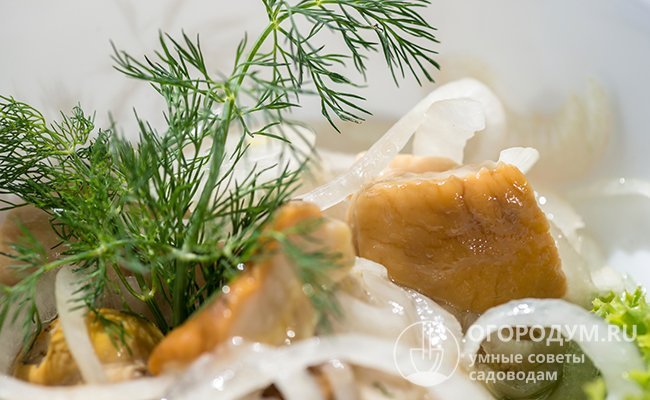
Servings / Volume: 2-2.5 l
Ingredients:
- boiled butter (boiled) - 3 kg;
- rock salt - 150 g;
- black pepper (peas) - 10-15 pcs.;
- allspice (peas) - 5-7 pcs.;
- garlic - 5-7 cloves;
- dill (umbrellas) - 5 pcs.;
- vegetable oil - 150 ml.
Cooking technology:
- Along the bottom of the capacious container, evenly distribute a handful of salt and some of the prepared spices: dill umbrellas, pepper, garlic chopped into slices.
- We spread the mushrooms with their caps down, sprinkling each layer of mushroom with salt and spices.
- Cover the filled container with a plate or lid and place the load on top.
- We leave the workpiece in a warm place for a day.
- We wash the cans of soda well, put the mushrooms in them and fill them with the released liquid.
- Pour several tablespoons of vegetable oil into each jar so that it completely covers the surface, and we seal the jars with nylon lids, preheated in boiling water.
- We remove the mushrooms in the refrigerator and let them salt for 2-3 weeks.
Salty boletus is tasty and aromatic, satisfying and nutritious, containing a large amount of plant proteins. They will become a real decoration of a regular, vegetarian or lean menu.
Many housewives do not have the opportunity to store blanks in the refrigerator, cellar or basement, so they often have to pickle or salt butter for the winter in banks in a hot way.
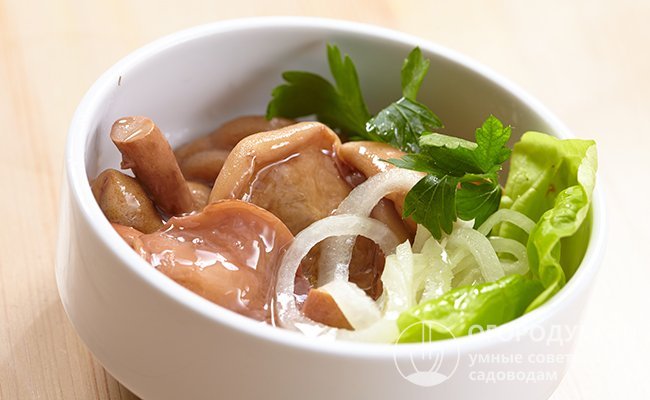
Servings / Volume: 2-2.5 l
Ingredients:
- boiled butter (boiled) - 3 kg;
- brine water - 1.5 l;
- rock salt - 3 tbsp. l .;
- sugar - 1.5 tbsp. l .;
- black and allspice pepper (peas) - 5-10 pcs.;
- bay leaf - 3-5 pcs.;
- dry cloves - 5-6 pcs.
Cooking technology:
- Place the peeled, boiled and washed mushrooms in an enamel pan and fill with water. We put on high heat and bring to a boil.
- Add all the spices and herbs to the pan. Boil mushrooms in brine for 20-30 minutes.
- While the mushrooms are boiling, wash the jars with soda and sterilize.
- Put the mushrooms hot in the jars, fill them with brine to the top and seal them tightly with lids.
- Cover the inverted jars with a blanket and leave to cool. You can store such a workpiece under normal conditions in a pantry or in a kitchen cabinet.
Using the same technology, you can not only salt butter, but also pickle by adding vinegar (9%) to the brine at the rate of 70-100 ml per 1 kg of mushrooms 5-10 minutes before the end of their cooking.
Video
We suggest you watch a few more recipes for salting and pickling butter in the following videos:
For several years she worked as a TV program editor with leading producers of ornamental plants in Ukraine. At the dacha, of all types of agricultural work, he prefers harvesting, but for this she is ready to regularly weed, pick, pinch, water, tie, thin out, etc. I am convinced that the most delicious vegetables and fruits are grown by your own hands!
Found a bug? Select the text with the mouse and click:
Ctrl + Enter
Both humus and compost are rightfully the basis of organic farming. Their presence in the soil significantly increases the yield and improves the taste of vegetables and fruits. They are very similar in properties and appearance, but they should not be confused. Humus - rotted manure or bird droppings. Compost - rotted organic residues of various origins (spoiled food from the kitchen, tops, weeds, thin twigs). Humus is considered a better fertilizer, compost is more readily available.
Tomatoes have no natural protection against late blight. If late blight attacks, any tomatoes (and potatoes too) die, no matter what is said in the description of varieties ("varieties resistant to late blight" is just a marketing ploy).
In small Denmark, any piece of land is a very expensive pleasure. Therefore, local gardeners have adapted to growing fresh vegetables in buckets, large bags, foam boxes filled with a special earthen mixture. Such agrotechnical methods allow you to get a harvest even at home.
The homeland of pepper is America, but the main breeding work on the development of sweet varieties was carried out, in particular, by Ferenc Horvat (Hungary) in the 20s. XX century in Europe, mainly in the Balkans. Pepper came to Russia from Bulgaria, therefore it got its usual name - "Bulgarian".
The novelty of American developers is the Tertill robot, which weeds in the garden. The device was invented under the leadership of John Downes (the creator of the robot vacuum cleaner) and works autonomously in all weather conditions, moving on uneven surfaces on wheels. In doing so, he cuts all plants below 3 cm with the built-in trimmer.
Compost - rotted organic residues of various origins. How to do it? Everything is stacked in a heap, a hole or a large box: kitchen leftovers, tops of garden crops, weeds mown before flowering, thin twigs. All this is interlayered with phosphate rock, sometimes with straw, earth or peat. (Some summer residents add special composting accelerators.) Cover with foil. In the process of reheating, the pile is periodically ted up or pierced for an influx of fresh air. Usually compost “matures” for 2 years, but with modern additives it can be ready in one summer season.
Oklahoma farmer Carl Burns has developed an unusual variety of colorful corn called Rainbow Corn. The grains on each ear are of different colors and shades: brown, pink, purple, blue, green, etc. This result was achieved through many years of selection of the most colored common varieties and their crossing.
In Australia, scientists have begun experiments to clone several grape varieties from colder regions. Climate warming, which is predicted for the next 50 years, will lead to their disappearance. Australian varieties have excellent characteristics for winemaking and are not susceptible to diseases common in Europe and America.

